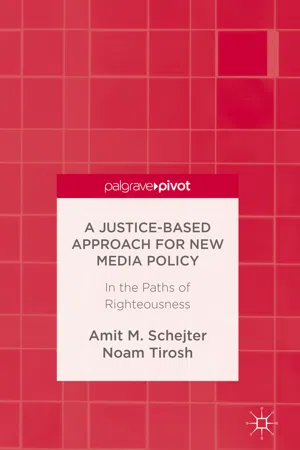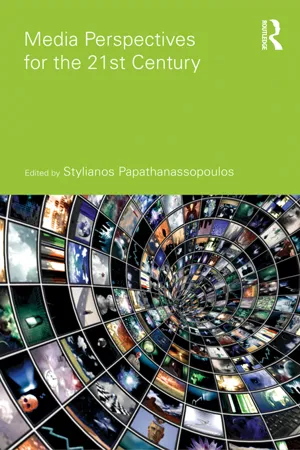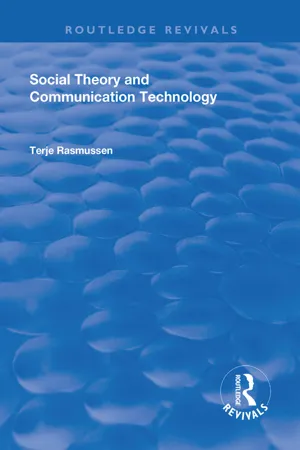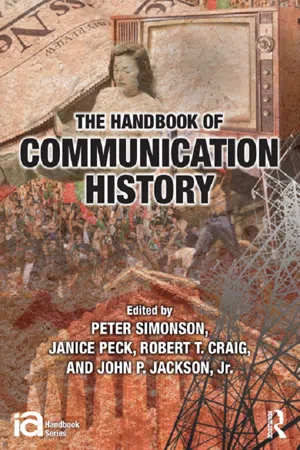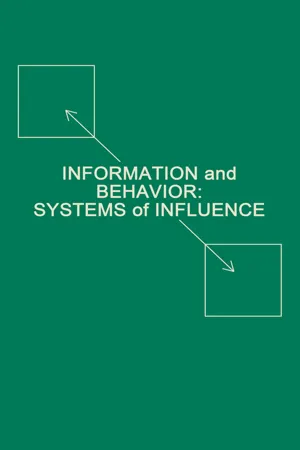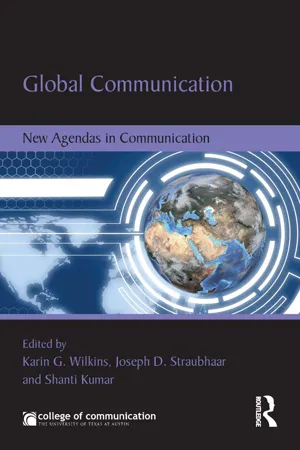Social Sciences
New Media
New media refers to digital communication technologies that have emerged in the late 20th and early 21st centuries, such as the internet, social media, and mobile devices. It encompasses the production, distribution, and consumption of digital content, enabling interactive and participatory communication. New media has transformed the way information is created, shared, and accessed, impacting various aspects of society and culture.
Written by Perlego with AI-assistance
Related key terms
11 Key excerpts on "New Media"
- eBook - ePub
- Denis McQuail, Mark Deuze(Authors)
- 2020(Publication Date)
- SAGE Publications Ltd(Publisher)
Chapter 4 , also indicates the rise of a new kind of society, quite distinct from mass society, one characterized by complex interactive networks of communication. In the circumstances, we need to reassess the main thrust of media social-cultural theory.The ‘New Media’ discussed here are in fact a disparate set of communication technologies that share certain features, apart from being relatively new, made possible by digitalization and being widely available for personal use as communication devices and infrastructures. From the outset we recognize with Nancy Baym that ‘newness is a state of time rather than of technology’ (quoted in Baym et al., 2012: 258), which should orient us to identifying concrete attributes or affordances of particular technologies instead of focusing on their novelty.As we have seen (p. 52), ‘New Media’ are very diverse and not easy to define, but we are particularly interested in those media and applications that on various grounds enter the sphere of mass communication or directly or indirectly have consequences for the ‘traditional’ mass media. Attention focuses mainly on the collective ensemble of activities that fall under the heading ‘Internet’, especially on the more public uses, including online news, advertising, broadcasting applications (including the downloading of music and the uploading of video, etc.), forums and discussion activities, the World Wide Web (WWW), information searches, certain community-forming potentials – all of which and more tend to be subsumed by online platforms and are offered through a wide array of information and communication technologies (ICTs). - eBook - ePub
A Justice-Based Approach for New Media Policy
In the Paths of Righteousness
- Amit M. Schejter, Noam Tirosh(Authors)
- 2016(Publication Date)
- Palgrave Macmillan(Publisher)
© The Author(s) 2016Begin AbstractA Justice-Based Approach for New Media Policy 10.1007/978-3-319-41510-9_2Amit M. Schejter andNoam Tirosh2. The Novelty and Utility in New Media
Amit M. Schejter 1, 2 andNoam Tirosh 1(1) Department of Communication Studies, Ben-Gurion University of the Negev, Beer Sheva, Israel(2) Institute for Information Policy, College of Communications, Penn State University, University Park, PA, USAAbstractWhat differentiates contemporary media from their predecessors is not that they are social, as would seem to be the case owing to their common descriptor as “social media,” but that they create an opportunity for a new type of mediated sociability. They differ from the traditional media that dominated the twentieth century in four aspects: they provide an abundance of available information, channels over which this information can travel, and storage space in which information can be retained; they are mobile; they are interactive; and they allow multimediated messages to be conveyed by users. These characteristics allow those that have the opportunity to use them the capability to communicate on richer levels that allow more presence. These features are at the heart of their democratic potential.Keywords New Media Social media Abundance Mobility Interactivity Multimediality Richness Presence Internet DemocracyEnd AbstractCommunication is an act in which human beings interact and information is mediated. Whether communication is perceived within the so-called rhetorical (McCroskey & Richmond, 1996 ) or transmission traditions (Shannon & Weaver, 1954 ) or whether it is seen within the relational (McCroskey & Richmond, 1996 ) or ritual (Carey, 1989 ) schools, no communication takes place unless information is involved in the process as well. Indeed, one need not trivialize the distinction between these different theoretical approaches to the term communication , yet one cannot overlook the fact that the two are not contradictory but rather complementary. In a sense, just like Williams (1958 /2014) acknowledges the existence of two distinct definitions of the word culture —a whole way of life as well as the arts and learning—yet “insist[s] on both and on the significance of their conjunction,” (Williams, 1958 - eBook - ePub
- Stylianos Papathanassopoulos(Author)
- 2011(Publication Date)
- Routledge(Publisher)
Although it is difficult to eradicate old media studies, one has to acknowledge that the spread of the new interactive media has generated an enormous pool of academic research and general public discourse, with assessments concerning the social implications of emerging communications and media technologies (McAllister and Turow, 2002 ; Jankowski et al. 1999). Nevertheless, when we refer to the current state of communication and media studies, most of the time we refer to the complex relationships between the state, the media and individuals either as a society or as individuals and we try to reassess these whilst using a new prism (see also McQuail, 2009 : 387). Regardless of their fragmentation, the field of communication and media studies has always been a fertile ground for debate, disputes and discussions. More so, when the landscape of communications has itself been undergoing enormous change. As relationships, processes and flows are all scrutinized by commentators, new insights and new interpretations come to the fore. One of the main aims of this book is to bring together diverse scholars in theory and research and to provide them with a forum in which they can explore contemporary issues and themes. In the recent past, discussions about the future of communication and media studies contained two main and interrelated issues. The first was whether there would be something called communication science in the twenty-first century. The second concerned the relations between the different approaches within the field which derive from different sciences and disciplines. On the first, many media scholars have given a positive answer. The convergence and the digitalization of the media, and before them the deregulation and privatization of the communications sector, have given rise to new concerns, problems and insights - eBook - ePub
- Eugenia Siapera(Author)
- 2017(Publication Date)
- SAGE Publications Ltd(Publisher)
new media, is clear to all of us. Televisions and radio sets have had a long presence in households in at least the developed world. But the rise of the New Media is associated with their ubiquity; they are found everywhere: in living rooms, offices and schools, in the streets, in playrooms and bedrooms. And what’s more they are found not only in the so-called developed world, but in developing countries as well. A recent study reports that mobile phones are now as common in certain parts of Africa as they are in the United States (Pew Research Center, 2015). This spread poses a series of important questions regarding society, but also about economic, political and cultural institutions, as well as our experiences. We may want to see these as increasingly, or perhaps even inevitably, mediated (Livingstone, 2009). In other words, the involvement of the New Media in society, the economy, politics, culture, the self and experiences is such that none of these escape unscathed. Understanding New Media, in this sense, means understanding how they interact with a series of social, economic, political, cultural and psychological processes, giving rise to a new kind of world. As we shall see, this world may not resemble very closely the one in McLuhan’s vision, but it can nevertheless be thought of as a New Media world.This chapter is concerned with providing the lens through which our interrogation of the New Media can take place. Theory, in its original Greek etymological roots, literally means view or sight; as such, theory constitutes a particular way of seeing and examining something. Social phenomena do not reveal themselves to us in their entirety but we look at them from specific viewpoints and analyse them from certain perspectives, commensurable with our expertise, level of knowledge, and historical positioning. It is necessary therefore to clarify the viewpoints and perspectives adopted here and the main assumptions and arguments they make. Two distinct but related theoretical lenses are required in our current interrogation of the New Media: one that concerns the relationship between technology and society, and one that concerns the New Media as media. The first section will cover the former and the second section will discuss the latter.Technology and Society
We can begin our interrogation of the relationship between society, media and the technologies that underlie them by posing the question, in the first instance, as a question of the relationship between technology and society. If New Media are new precisely because they rely on new technologies, then before looking at their actual mediation, it may be worth considering the relationship between technology and society. Does technology determine society? Or does society determine technology? What are the effects of technology on society? Is technology good or bad? There are three possible answers to this question, which mobilize a different version of what technology is. This is based on Darin Barney’s (2004) classification of theories of technology into three categories: instrumentalism, substantivism and social constructivism. - eBook - ePub
- Andrew Dewdney, Peter Ride(Authors)
- 2013(Publication Date)
- Routledge(Publisher)
There are a growing number of digital media titles on the bookshelves and in some important respects there is an overlap between work being described as New Media and that defined as digital media. The main problem with the term digital media is that it has a tendency to privilege technology itself as the defining aspect of a medium, as if all digital media practice will be first and foremost about, or reflect the character of, digital technology. However, continued technical convergence in media production alongside of the growth of social media now questions the emphasis upon both sets of terms. New Media, for example is now very much the established basis of most online user practices and digital media is entailed in most media production, leaving us with the question: what does either term distinguish?The term New Media still signals more about the dimension of the contemporary cultural concepts and contexts of media practices than it does about simply an integrated set of technologies. It is important and absolutely central to the approach of this book that the technological means and cultural and expressive practices are thought of as inseparable parts of the term digital media. The relationship between technologies and cultural and media practices needs to be understood as linked at every stage, from strategy, research and development to use. While this book has now adopted the term digital media over that of New Media, this is in part because of the recognition that New Media builds in its own redundancy. It takes little mental effort to reflect that all media must have been new at some point in their history and the question is then quickly begged, when will New Media stop being new and become old or just media? The general answer is of course that New Media will become old media when something else comes along that is significantly different. Superficially, the term New Media suggests that at the core of its meaning it is its ‘newness’, or novelty that interests and excites. But novelty is by nature ephemeral and the excitement of the new quickly wears thin. The new, by definition, has not stood the test of time, but historically we are aware that the new can also indicate a set of more radical and fundamental shifts and changes in the ways in which human affairs are conducted. Hindsight has taught us that the twentieth century contains a catalogue of ‘the new’ in many areas of everyday life as well as in extraordinary scientific and cultural achievement. Indeed, the twentieth century was established on the legacy of progress bequeathed by the industrial revolution. Ideas about the newness of New Media and its technological base are deeply rooted in the historical notion of social and scientific progress. - eBook - ePub
Reading Media Theory
Thinkers, Approaches and Contexts
- Brett Mills, David M. Barlow(Authors)
- 2014(Publication Date)
- Routledge(Publisher)
New Media: An introduction , 2nd edition, Oxford: Oxford University Press. Explores New Media within a global context, in social, economic and politics terms.- Kyong, W.H., and Keenan, T. (eds) (2006) New Media, Old Media: A history and theory reader , New York and London: Routledge. Useful collection of readings, especially as it makes links between all forms of media and offers a historical context.
- van Dijk, J.A.G.M. (2006) The Network Society: Social aspects of New Media
- eBook - ePub
- Terje Rasmussen(Author)
- 2019(Publication Date)
- Routledge(Publisher)
5 New Media and the Contexts of Daily LifeCommunication technologies set off new contexts for communication in very different ways from both print media and electronic mass media. At issue in this essay is the transformation of agency and interaction from particular places into communicative situations — the substitution of place for an expanded space. I’d like to address the relationships between media technologies, social interaction and forms of social context, and to draw some ideal-typical and practical lines between forms of communication and contexts.In relation to media technologies, contexts pose several complicated questions. For instance, what is the ‘context’ when watching television or engaged in computer-mediated communication? How should we characterise communicative practices when material and communicative contexts overlap and blend into new ones? Such questions indicate how difficult it is to understand the communicative experiences of the modern individual with the wide range of modes of mediation at hand which reproduce and disintegrate the lifeworld.The term ‘contextualization’ refers here to the digital construction of context — how communication technologies take part in the construction and reproduction of contexts of symbolic action. In contrasting the contextual significance of communication technologies with electronic (mass) media, I shall seek to expose significant aspects of the dynamics of communication technologies in the contextual constitution of agency. Surely, communication technologies do not ‘decontextualise’ communication, as is argued (see Feenberg, 1991: 99), they recontexualise - eBook - ePub
- Peter Simonson, Janice Peck, Robert T Craig, John Jackson(Authors)
- 2013(Publication Date)
- Routledge(Publisher)
14 New Media
Benjamin Peters and Rasmus Kleis Nielsen DOI: 10.4324/9780203149119-14It is an extraordinary era in which we live. It is altogether new. The world has seen nothing like it before. U.S. Senator Daniel Webster, 1847New Media can be understood as media we do not know how to talk about.1 Today, the term seems nearly synonymous with digital media, but that has not always been so. Other media have perplexed us before and different New Media perplex people differently; hence New Media appear historiographically hazardous. In the long view, since each medium must be new before it becomes old, New Media predate old media, and every age may be understood as an age of its own New Media, “the age of print” no less than “the age of television” or “the internet age” (Marvin 1988 ). In the short term, the situation appears just the opposite: mortgaged to the present, New Media—a near synonym with “now media”—appears as media without history. Here today, gone tomorrow, New Media have fueled a brisk industry of speculative commentary but less careful scrutiny. They have a long past but too often short and disjoint histories. In this chapter, we take brief account of New Media history as a field of inquiry aimed at producing these histories, an endeavor that does not constitute a single scholarly field, discipline, or sub-discipline, but rather is practiced across departments of history, media and communication studies, science and technology studies, anthropology, sociology, and more. New Media history is, in our view, not simply the history of digital media but rather a particular aspect—novelty—part of all media history, stretching from what may be the first digital medium, the index finger, to the latest gadget or piece of software (Wade 2006 - eBook - ePub
- Eoin Devereux(Author)
- 2013(Publication Date)
- SAGE Publications Ltd(Publisher)
New Media, Social MediaChapter overviewBuilding on core themes previously discussed (such as the power of multimedia conglomerates, the relative degree of agency possessed by audiences and the changing nature of the media industries themselves), this chapter presents a critical account of New Media and social media. Drawing from the political economy perspective, it explains how:• Unequal power relationships and the hegemony of multimedia conglomerates in particular continue to shape and determine the uses of both New Media and social media• It is problematic to assume (as some utopian commentators do) that New Media and social media offer audiences unlimited possibilities in terms of creativity or agency. In fact, the growth in audience participation in a New Media setting can be seen as a source of free labour for multimedia conglomerates• Notwithstanding the positive developments that have taken place in terms of citizen journalism, New Media and social media have also had negative impacts for the production of news and some sections of the media industries. This is of particular importance when we focus on issues concerning the extent to which New Media have facilitated active citizenship in a media setting.Key concepts• Social media• New Media• Convergence• Public sphere• Citizenship• Netizens• Networked individuals• Political economy• Democratization• Produsers/prosumers• Blogging• Citizen journalismIntroduction: New Media and social media – empowering audiences, but who is holding the tiger’s tail?Developments in New Media and the emergence of social media networks have radically altered how we now understand the media. Technological innovations in terms of the media devices, software and apps we use have resulted in new ways of experiencing and using the media. Although many early New Media theorists heralded the advent and spread of the internet as being a great leveller – a force for democracy, innovation and sharing of information and knowledge amongst the world’s citizens – the reality is somewhat different. While free content (e.g. Wikipedia), free software and other applications (e.g. Open Source) are available, the majority of New Media usage takes place using technologies produced, distributed and controlled by global multimedia conglomerates (e.g. YouTube). The internet is still more likely to be used to source pornography, to check out the vital statistics of the latest model of car or to catch up with the latest celebrity gossip than it is to be a public sphere facilitating informed debate and argument about how society might be best organized. As will be clear from this chapter, the availability of New Media and the spread of social media networks are of major importance where both media organizations and media audiences are concerned. New Media present both opportunities and challenges for multimedia conglomerates. As was previously pointed out in Chapter 3 , New Media technologies allow not only for convergences - eBook - ePub
Information and Behavior
Systems of Influence
- Richard A. Winett(Author)
- 2013(Publication Date)
- Routledge(Publisher)
3. Conceptual and methodological aspects of the behavioral systems framework can be applied to analyses of New Media. Although somewhat speculative at this point, given the dearth of research, the adaptability of the framework to other problems in information and behavior suggests applicability here. At the same time, perspectives and conclusions derived from others (i.e., McGuire, Atkin), should also have general applicability.The New MediaRice’s (1984c) seminal social science book, The New Media: Communication, research, and technology, serves as a basic reference for a number of sections of this chapter. However, the objective here is to bring only key parts of the very detailed information presented by Rice into the perspectives of this chapter and volume. Thus, there is not any attempt to comprehensively review that book.According to Rice, the New Media primarily have changed the channel of communication, rather than specific content or purposes. However, if “the medium is the message,” then it is apparent that a change in medium almost inevitably alters content and purpose.The New Media include PC’s, videotext, and teletext, interactive cable systems, various computer games, videodiscs, electronic mail, computer conferencing, communication satellites, and office information systems. Major overriding dimensions of the New Media are: speed of access; interactivity; the linking of communication and computer systems, i.e., “compunications,” as well as the linkage of different media systems; variability in the time and place of communication; incredible capabilities for storing and arranging information, and blurring of distinctions between different media and technical and artistic endeavors. These major dimensions are captured in this extended quote from Rice (1984d): - eBook - ePub
Global Communication
New Agendas in Communication
- Karin Wilkins, Joe Straubhaar, Shanti Kumar(Authors)
- 2013(Publication Date)
- Routledge(Publisher)
Chapter 10New Mediations in the Digital AgeJosé María García de MadariagaAn Analysis of Global Communication through Professional JournalistsSocial communication has been transformed by new paradigms involving digitalization: interactivity, customization, the use of multimedia, hypertext links, unlimited amounts of information that may be continually updated, and finally, the gradual transformation of traditional processes of informative mediation, six of the main keys of global communication (Orihuela 2002). However, changes that promote new information and communication technologies (ICTs) in the field of journalism are much more significant than in news broadcasting, increasingly more and more abundant, unmediated and in real time, or “journalism on demand.” These phenomena could be, as Ignacio Ramonet (2001, pp49–50) has warned, worrying signs of the “tyranny of communication” prevalent in today's globalized world, in which he says “seeing is understanding”: “The system blames the receiver [of information] who can now denounce [misinformation as] lies, because he has become informed on his own.”Such concerns lead us to wonder who benefits from and who is harmed by the digitization of journalism, a process that, while closely related to globalization, is not restricted to the technological aspects of this phenomenon. This question also requires us to understand the magnifying impact digitization has upon the structural imbalances in the production, circulation, and accessibility of information, imbalances that in our globalized era led to the creation of a “digital divide.” But it also suggests that digital technologies offer citizens exciting opportunities to engage as potentially significant players in the journalistic arena, possibly redressing the growing imbalance that results from the hegemonic influence of much larger and many fewer media companies.
Learn about this page
Index pages curate the most relevant extracts from our library of academic textbooks. They’ve been created using an in-house natural language model (NLM), each adding context and meaning to key research topics.

